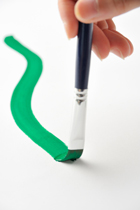 After you decide to learn to paint, the first thing often encountered is the temptation to grapple with the thorny question of whether or not you have talent.
After you decide to learn to paint, the first thing often encountered is the temptation to grapple with the thorny question of whether or not you have talent.
Have you got talent?
There are two schools of thought. The first is that everyone is creative in their own way. The other is that true art belongs only to the elite with sufficient talent to express a unique point of view. There is whole industry built around this, but either way, some of our most famous contemporary painters started off quietly for some years before awareness of their work grew. What matters most is passion and enthusiasm. Who knows what is in store for you?
Where to start?
Working out why you want to learn to paint makes whole sets of decisions easier down the line. These include establishing a ballpark figure of how much money you are going to throw at materials and working out where you are going to paint. Is it purely for your own enjoyment or do you intend to have an exhibition one day? Will you frame some works and hang them on the wall? If so, investing in paper or canvas or other material that will last the distance makes a lot of sense, but otherwise maybe not initially until you find your feet.
The most commonly used paints are oils, acrylics, watercolours and pastels. There are some great personality quizzes on the net to help you choose which is best for you and it does seem to be a personality thing!
What type of painting?
A key factor in choosing what kind of paints to use is how you intend to handle mistakes.
Using oils means if something is not working, you can scape it off or paint over it when it dries, but requires a certain degree of comfort with paint fumes, the smell of turps, and the prospect of mixing colours and spending the time cleaning brushes. Are kids going to be running around your feet or around your drying artworks? Do you have a quiet, uninterrupted and well ventilated space to do your own thing? Alternatively, can you handle the thought of accidentally getting paint on the carpet?
Using acrylics and watercolours often means just starting again.
Do you expect to use just a few basic colours and mix your own from those or do you want boxes of colour to choose from? What kind of colours do you want to use – bright, clear colours or subtly shifting shades? How long do you want to wait for paintings to dry? How quickly do you want to work? How much time do you expect to spend on each painting?
Going into an art shop feels like the equivalent of a child walking into a toy shop. There are so many cool and expensive things to play with! Establish how much you want to spend before you cross the threshold is the safest bet. You can spend a fortune on materials so start off investing in colours and paper or canvas that allows you room to grow, to make mistakes without too much regret and to play, to explore your creativity and see where it takes you.
Some great links to explore:









Join the Discussion
Type out your comment here:
You must be logged in to post a comment.